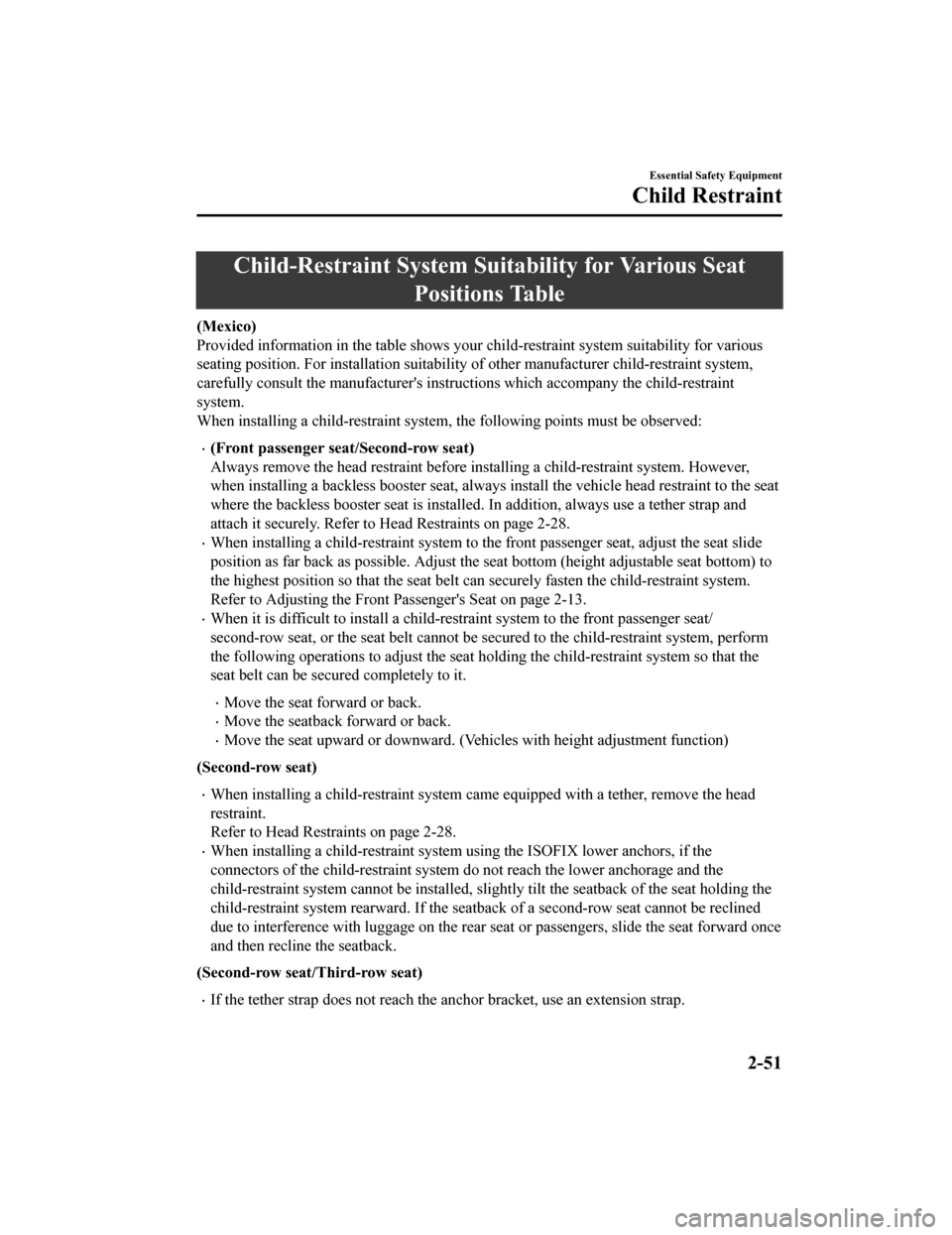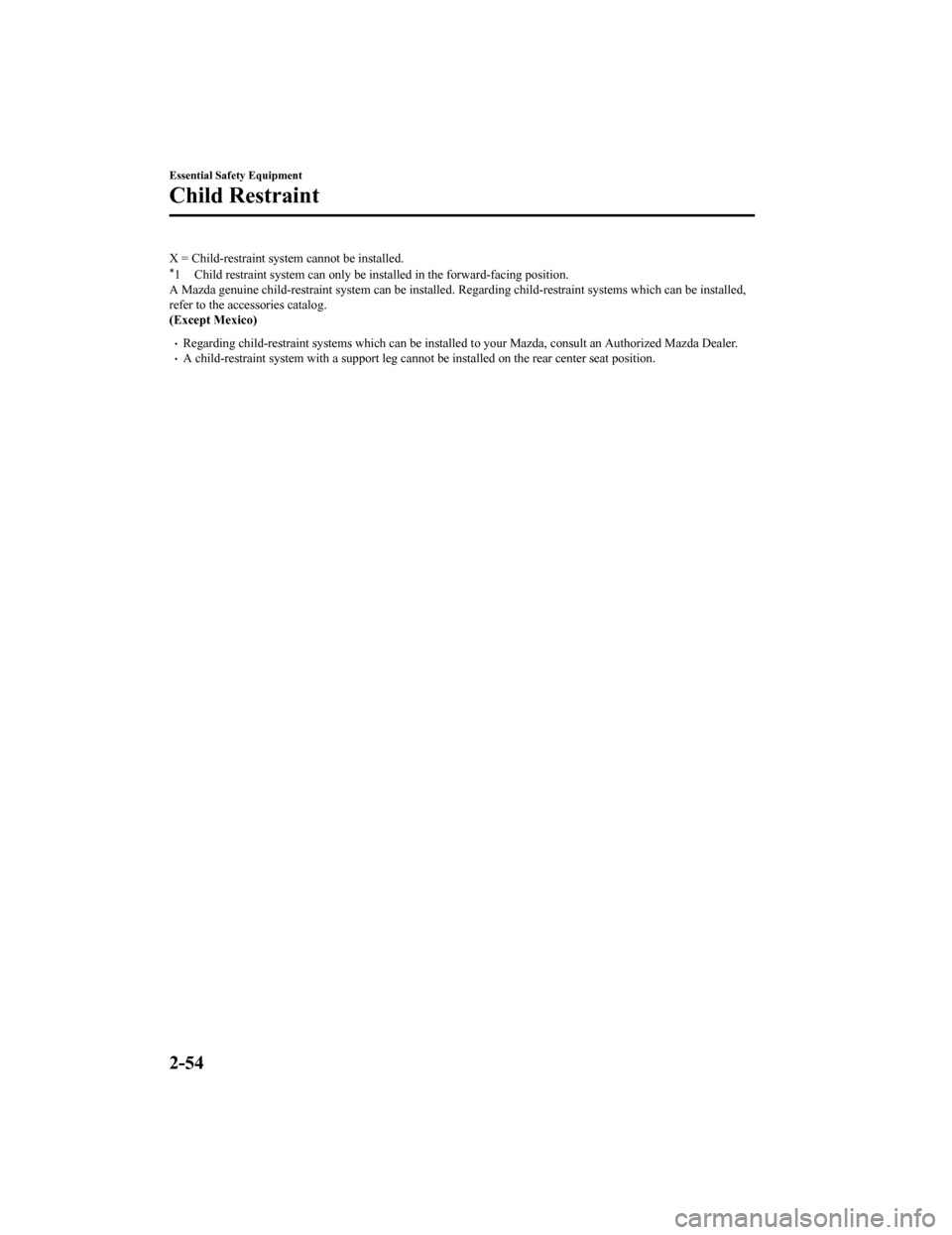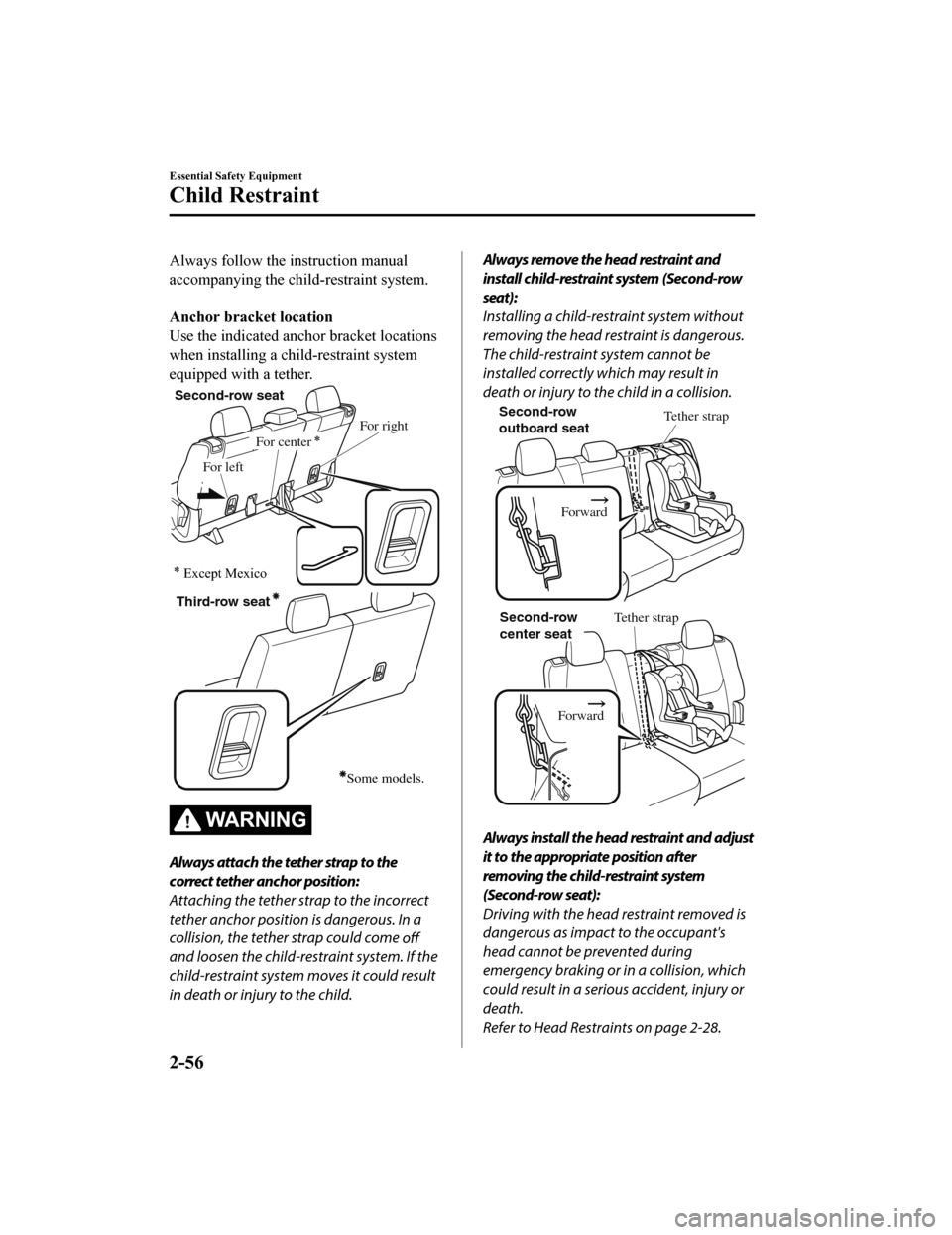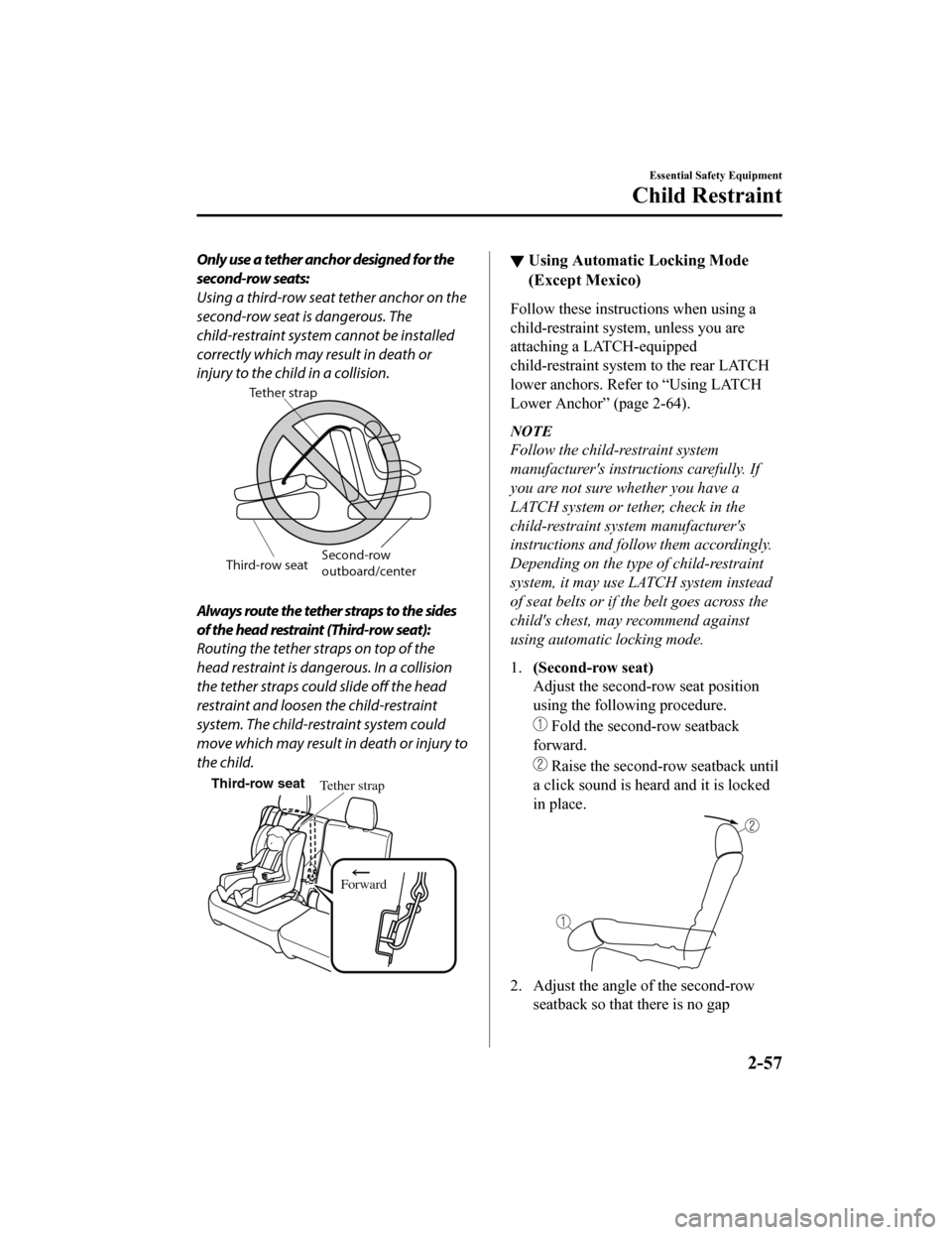MAZDA MODEL CX-9 2020 (in English) Repair Manual
Manufacturer: MAZDA, Model Year: 2020, Model line: MODEL CX-9, Model: MAZDA MODEL CX-9 2020Pages: 706
Page 61 of 706

Child-Restraint System Installation
▼Categories of Child-Restraint Systems
NOTE
When purchasing, ask the manufacturer of the child-restraint system which type of
child-restraint system is appropriate for your child and vehicle.
(Mexico)
Child-restraint systems are clas
sified into the following 5 groups according to the UN-R 44
regulation.
Group Age WeightSize Classification/
Fixture (CRF)
0 Up to about 9 months old Up to 10 kg (up to 22 lb) ISO/L1
ISO/L2
ISO/R1
0+ Up to about 2 years old Up to 13 kg (up to 29 lb) ISO/R1
ISO/R2
ISO/R3
1 About 8 months to 4 years old 9 kg ― 18 kg (20 lb ― 40 lb) ISO/R2
ISO/R3
ISO/F2
ISO/F2X ISO/F3
2 About 3 to 7 years old 15 kg ― 25 kg (33 lb ― 55 lb) ―
3 About 6 to 12 years old 22 kg ― 36 kg (48 lb ― 79 lb) ―
(Except Mexico)
Please comply with the legal regulations concerning the use of child-restraint systems in
your country.
▼ Child-Restraint System Types
In this owner's manual, explanation of
child-restraint systems is provided for the
following three types of popular
child-restraint systems: infant seat, child
seat, booster seat.
NOTE
Installation position is determined by
the type of child-restraint system.
Always read the manufacturer's
instructions and this owner's manual
carefully.
Essential Safety Equipment
Child Restraint
2-49
CX-9_8HT8-EA-19I_Edition2_old
2019-9-24 13:14:55
Page 62 of 706

Due to variations in the design of
child-restraint systems, vehicle seats
and seat belts, all child-restraint systems
may not fit all seating positions. Before
purchasing a child-restraint system, it
should be tested in the specific vehicle
seating position (or positions) where it
is intended to be used. If a previously
purchased child-restraint system does
not fit, you may need to purchase a
different one that will.
Infant seat
An infant seat provides restraint by
bracing the infant's head, neck and back
against the seating surface.
Equal to Group 0 and 0+ of the UN-R 44
and UN-R 129 regulation.
Child seat
A child seat restrains a child's body using
the harness.
Equal to Group 1 of the UN-R 44 and
UN-R 129 regulation.
Booster seat
A booster seat is a child restraint
accessory designed to improve the fit of
the seat belt system around the child's
body.
Equal to Group 2 and 3 of the UN-R 44
and UN-R 129 regulation.
When using a backless booster seat, always
install the vehicle head restraint to the seat
where the backless booster seat is installed.
Backless booster seat
*1
*1
Essential Safety Equipment
Child Restraint
2-50
CX-9_8HT8-EA-19I_Edition2_old
2019-9-24 13:14:55
Page 63 of 706

Child-Restraint System Suitability for Various SeatPositions Table
(Mexico)
Provided information in the table shows your child-restraint system suitability for various
seating position. For installati on suitability of other manufact urer child-restraint system,
carefully consult the manufacturer's instructions which accompany the child-restraint
system.
When installing a child-restraint system , the following points must be observed:
(Front passenger seat/Second-row seat)
Always remove the head restraint before installing a child-restraint system. However,
when installing a backless booster seat, always install the vehicle head restraint to the seat
where the backless booster seat is installed. In addition, always use a tether strap and
attach it securely. Refer to He ad Restraints on page 2-28.
When installing a child-restraint system to the front passenger seat, adjust the seat slide
position as far back as possible. Adjust the seat bottom (height adjustable seat bottom) to
the highest position so that the seat belt can securely fasten the child-restraint system.
Refer to Adjusting the Front Passenger's Seat on page 2-13.
When it is difficult to install a child-restraint system to the front passenger seat/
second-row seat, or the seat belt cannot be se cured to the child-restraint system, perform
the following operations to adju st the seat holding the child-restraint system so that the
seat belt can be secured completely to it.
Move the seat forward or back.
Move the seatback forward or back.
Move the seat upward or downward. (Vehicles with height adjustment function)
(Second-row seat)
When installing a child-restraint system came equipped with a tether, remove the head
restraint.
Refer to Head Restraints on page 2-28.
When installing a child-restraint system using the ISOFIX lower anchors, if the
connectors of the child-restraint system do not reach the lower anchorage and the
child-restraint system cannot be installed, slightly tilt the seatback of the seat holding the
child-restraint system rearward . If the seatback of a second-row seat cannot be reclined
due to interference with luggage on the rear seat or passengers, slide the seat forward once
and then recline the seatback.
(Second-row seat/Third-row seat)
If the tether strap does not reach the anchor bracket, use an extension strap.
Essential Safety Equipment
Child Restraint
2-51
CX-9_8HT8-EA-19I_Edition2_old 2019-9-24 13:14:55
Page 64 of 706

When installing a child-restraint system to the second-row seat or third-row seat, adjust
the seat position of the front seat so that the child-restraint system does not contact the
front seat.
Refer to Adjusting the Driver's Seat on page 2-5.
Refer to Adjusting the Front Passenger's Seat on page 2-13.
Refer to Seat Operation on page 2-15.
When installing a child-restrain t system to the rear seat, refer to the child-restraint system
manufacturer's instructions and the Using ISOFIX Lower Anchor on page 2-64.
An i-Size child-restraint system refers to a child-restraint system which has acquired
i-Size category certification for the UN-R 129 regulation.
Seating posi- tion Passenger Second-row
seat (Left) Second-row
seat (Center) Second-row
seat (Right) Third-row
seat (Left) Third-row
seat (Right)
Seating posi-
tion suitable
for universal
belted
(Yes/No) No Yes (U) Yes (U) Yes (U) Yes (U) Yes (U)
i-Size seating
position
(Yes/No) No
NoNoNoNoNo
Largest suita-
ble rearward
facing fixture
(R1) No Yes (IL) No Yes (IL) No
No
Largest suita-
ble rearward
facing fixture
(R2) No Yes (IL) No Yes (IL) No
No
Largest suita-
ble rearward
facing fixture
(R2X) No Yes (IL) No Yes (IL) No
No
Largest suita-
ble rearward
facing fixture
(R3) No Yes (IL) No Yes (IL) No
No
Largest suita-
ble forward
facing fixture
(F2) No Yes (IUF) No Yes (IUF) No
No
Essential Safety Equipment
Child Restraint
2-52
CX-9_8HT8-EA-19I_Edition2_old 2019-9-24 13:14:55
Page 65 of 706

Seating posi-tion Passenger Second-row
seat (Left) Second-row
seat (Center) Second-row
seat (Right) Third-row
seat (Left) Third-row
seat (Right)
Largest suita-
ble forward
facing fixture
(F2X) No Yes (IUF) No Yes (IUF) No
No
Largest suita-
ble forward
facing fixture
(F3) No Yes (IUF) No Yes (IUF) No
No
Largest suita-
ble lateral fac-
ing fixture
(L1) No
NoNoNoNo No
Largest suita-
ble lateral fac-
ing fixture
(L2) No
NoNoNoNo No
Largest suita-
ble booster
fixture
(B2) No Yes (IUF) No Yes (IUF) No
No
Largest suita-
ble booster
fixture
(B3) No Yes (IUF) No Yes (IUF) No
No
Non i-size
compatible
with a support
leg (Yes/No) Ye s
*1Ye s
N oYe s Ye sYe s
Lower ISO-
FIX anchorag-
es but without
To p Te t h e r
(Yes/No) No
NoNoNoNo No
U = Suitable for “universal” category restraints approved for use in this mass group.
UF = Suitable for forward-facing “universal” category restraints approved for use in this mass group.
IUF = Suitable for ISOFIX forward child restraints system s of universal category approved for use in the mass
group.
L = Suitable for particular child restrain ts given on attached list. These restraints may be of the “specific vehicle”,
“restricted” or “semi-universal” categories.
IL = Suitable for particular ISOFIX child restraint system s (CRS) given in the attached list. These ISOFIX CRS are
those of the “specific vehicle”, “restr icted” or “semi-universal” categories.
i-U = Suitable for i-Size “universal” Child Res traint Systems forward and rearward facing.
i-UF = Suitable for forward-facing i-Size “universal” Child Restraint Systems only.
Yes = Child-restraint system can be secured on the seat.
No = Child-restraint system cannot be secured on the seat, or there is no fixture.
Essential Safety Equipment
Child Restraint
2-53
CX-9_8HT8-EA-19I_Edition2_old 2019-9-24 13:14:55
Page 66 of 706

X = Child-restraint system cannot be installed.*1 Child restraint system can only be installed in the forward-facing position.
A Mazda genuine child-restraint system can be installed. Regarding child-restraint systems which can be installed,
refer to the accessories catalog.
(Except Mexico)
Regarding child-restraint systems which can be installed to your Mazda, consult an Authorized Mazda Dealer.A child-restraint system with a support leg cannot be installed on the rear center seat position.
Essential Safety Equipment
Child Restraint
2-54
CX-9_8HT8-EA-19I_Edition2_old 2019-9-24 13:14:55
Page 67 of 706

Installing Child-RestraintSystems
Accident statistics reveal that a child is
safer in the rear seat. The front passenger's
seat is clearly the worst choice for any
child under 12, and with rear-facing
child-restraint systems it is clearly unsafe
due to air bags.
NOTE
Even if your vehicle is equipped with front
passenger occupant classification sensor
(page 2-84), which automatically
deactivates the front passenger air bag, a
rear seat is the safest place for a child of
any age or size.
Some child-restraint systems now come
with tethers and therefore must be
installed on the seats that take tethers to be
effective. In your Mazda, tethered
child-restraint systems can only be
accommodated in the four positions on the
rear seat.
Some child-restraint systems also employ
specially designed ISOFIX/LATCH
*1
attachments; refer to " (Mexico) Using
ISOFIX Lower Anchor (Second-Row
Seats)/(Except Mexico) Using LATCH
Lower Anchor (Second-Row Seats)" (page
2-64).
*1 ISOFIX (Mexico)/LATCH (Except
Mexico)
WA R N I N G
Tethered Child-Restraint Systems Work
Only on Tether-Equipped Rear Seats:
Installation of a tether equipped
child-restraint system in the front
passenger's seat defeats the safety design
of the system and will result in an increased
chance of serious injury if the
child-restraint system goes forward
without benefit of being tethered.
Place tether equipped child-restraint
systems where there are tether anchors.
▼Anchor Bracket
Anchor brackets for securing
child-restraint systems
are equipped in the
vehicle. Locate each anchor position using
the illustration.
To install a child-restraint system, remove
the head restraint (e xcept third-row seat).
Essential Safety Equipment
Child Restraint
2-55
CX-9_8HT8-EA-19I_Edition2_old 2019-9-24 13:14:55
Page 68 of 706

Always follow the instruction manual
accompanying the child-restraint system.
Anchor bracket location
Use the indicated anchor bracket locations
when installing a child-restraint system
equipped with a tether.
For right
For center
For left
Second-row seat
* *
Except Mexico
Third-row seat
Some models.
WA R N I N G
Always attach the tether strap to the
correct tether anchor position:
Attaching the tether strap to the incorrect
tether anchor position is dangerous. In a
collision, the tether strap could come off
and loosen the child-restraint system. If the
child-restraint system moves it could result
in death or injury to the child.
Always remove the head restraint and
install child-restraint system (Second-row
seat):
Installing a child-restraint system without
removing the head restraint is dangerous.
The child-restraint system cannot be
installed correctly which may result in
death or injury to the child in a collision.
Tether strap
Forward
Second-row
outboard seat
Tether strap
Forward
Second-row
center seat
Always install the head restraint and adjust
it to the appropriate position after
removing the child-restraint system
(Second-row seat):
Driving with the head restraint removed is
dangerous as impact to the occupant's
head cannot be prevented during
emergency braking or in a collision, which
could result in a serious accident, injury or
death.
Refer to Head Restraints on page 2-28.
Essential Safety Equipment
Child Restraint
2-56
CX-9_8HT8-EA-19I_Edition2_old
2019-9-24 13:14:55
Page 69 of 706

Only use a tether anchor designed for the
second-row seats:
Using a third-row seat tether anchor on the
second-row seat is dangerous. The
child-restraint system cannot be installed
correctly which may result in death or
injury to the child in a collision.
Tether strap
Third-row seatSecond-row
outboard/center
Always route the tether straps to the sides
of the head restraint (Third-row seat):
Routing the tether straps on top of the
head restraint is dang
erous. In a collision
the tether straps could slide off the head
restraint and loosen the child-restraint
system. The child-restraint system could
move which may result in death or injury to
the child.
Tether strap
ForwardThird-row seat
▼Using Automatic Locking Mode
(Except Mexico)
Follow these instructions when using a
child-restraint system, unless you are
attaching a LATCH-equipped
child-restraint system
to the rear LATCH
lower anchors. Refer to “Using LATCH
Lower Anchor” (page 2-64).
NOTE
Follow the child-restraint system
manufacturer's instru ctions carefully. If
you are not sure whether you have a
LATCH system or tether, check in the
child-restraint system manufacturer's
instructions and follow them accordingly.
Depending on the type of child-restraint
system, it may use LATCH system instead
of seat belts or if the belt goes across the
child's chest, may recommend against
using automatic locking mode.
1. (Second-row seat)
Adjust the second-row seat position
using the following procedure.
Fold the second-row seatback
forward.
Raise the second-row seatback until
a click sound is heard and it is locked
in place.
2. Adjust the angle of the second-row seatback so that there is no gap
Essential Safety Equipment
Child Restraint
2-57
CX-9_8HT8-EA-19I_Edition2_old 2019-9-24 13:14:55
Page 70 of 706

between the child-restraint system and
the second-row seatback.
3. Make sure the seatback is securely
latched by pushing it back until it is
fully locked.
4. (Second-row seat)
Remove the head restraint. However,
when installing a backless booster seat,
always install the vehicle head restraint
to the seat where the backless booster
seat is installed.
Refer to Head Restraints on page 2-28.
5. Secure the child-restraint system with the lap portion of the lap/shoulder belt.
See the manufacturer's instructions on
the child-restraint system for belt
routing instructions.
6. To get the retractor into the automatic locking mode, pull the shoulder belt
portion of the seat belt until the entire
length of the belt is out of the retractor.
7. Push the child-res traint system firmly
into the vehicle seat. Be sure the belt
retracts as snugly as possible. A
clicking noise from the retractor will
be heard during retraction if the system
is in the automatic locking mode. If the
belt does not lock the seat down tight,
repeat this step.
NOTE
Inspect this function before each use
of the child-restraint system. You
should not be able to pull the
shoulder belt out of the retractor
while the system is in the automatic
locking mode. When you remove the
child-restraint system, be sure the
belt fully retracts to return the
system to emergency locking mode
before occupants use the seat belts.
8. If your child-restraint system requires the use of a tether strap, refer to the
manufacturer's instructions to hook
and tighten the tether strap.
WA R N I N G
Use the tether and tether anchor only for a
child-restraint system:
Using the tether or tether anchor to secure
anything but a child-restraint system is
dangerous. This could weaken or damage
the tether or tether anchor and result in
injury.
Essential Safety Equipment
Child Restraint
2-58
CX-9_8HT8-EA-19I_Edition2_old 2019-9-24 13:14:55